Posted by
Susan Sharma
on
July 05, 2007
"The Great Indian Tiger Crisis" won the award for Best Point of View at the International Wildlife Film Festival 2007 at Montana, USA
Synopsis
The Great Indian Tiger Crisis
Mirror Films Private Limited
Producer: Arindam Mitra
India was shocked to learn, in early 2005 that some of her Tiger Reserve Forests had actually no tigers left. The Prime Minister set up a task force with eminent conservationists and sent them out on a fact finding mission across the length and breadth of
the vast number of Reserve Forests. This film stalks the task force to unearth shocking facts and becomes an important critique of the conservation policies in India. Part road movie, part fact finding, part political discourse and part philosophy this is
a fascinating piece of film too. (77 min)
|
Posted by
Susan Sharma
on
June 29, 2007
Here is an amusing story from Ahmedabad. A flock of sparrows has been pecking at three friends living in Ahmedabad since three days. The pecking is so severe that the men cannot go out of their homes and one day the birds even chased the men nearly a kilometer
away.
It all started from an effort by Shastri and his friends to help two fledglings, which fell from their nest after being attacked by a cat in his frontyard. "The sparrows thought we had killed her babies and started pecking us on the head." said Shastri.
The friends thought that was the end, but in the evening, they were attacked again by the sparrows near a pan shop. The next day too, the sparrows had not forgotten them. The men are now planning ways to sneak out of their homes.
Source Times of India June 29, 2007
|
Posted by
Jacob Koshi
on
June 27, 2007

A visit to Kruger Park in South Africa
-Jacob Koshi M
Flights to South Africa from India are operated by Qatar Airways, Emirates, South African Airways etc. One can book tickets through the travel agent or directly through the internet.
In case of planning to club with visits to another country, request for Multiple Entry visas from the South African Embassy in Mumbai. Booking can be made through the net for stay in the tourist lodges or hotels near the Kruger Park. I stayed in a resort
called Kruger Park Lodge which is close to Kruger Park. Bookings can be made through the internet to this place. Or if one is a member of Mahindra Resorts or RCI, they have affiliations to this place.
For those who intend to visit the Kruger Park, the following description & tips will help in planning the trip.
Johannesburg to Nelspruit 350 kms Nelspruit to Whiteriver 23 kms Whiteriver to Hazyview 45 kms Hazyview to Paul Kruger Gate 41kms. Total = 459kms
City bug (the 14 seater minibuses) operates from Joberg airport to Hazyview for Rand 200/- You can book your tickets online on www.citibug.com & pay using your credit card sitting in India. The driver will have a computerised list of passengers. Show them
your identity & he will take you in. There are other minibus operators also through whom you can book your tickets. Book your tickets both ways mentioning your date of journey & date of departure. For travel from Hazyview to Kruger Park Lodge (which is outside
the Kuger Park), one can email & request for the Lodge’s vehicle for pickup for this small distance. This way, one can save lot of money for transport.
The lodge will arrange pick up from Joberg airport, but the rates will be prohibitively expensive. Once inside the resort, book your trips with tour operators who liaise with the lodge. Give them your preference of next day’s trips (they will explain over
the phone the type of trip, rate etc) & your credit card number as security, they will collect you from your chalet at the preset time & drop you back after the trip.
In my case, I have booked a jeep safari trip starting at 5.45am & ending at 12.30pm. Carry some cloths for the cold weather. The Kruger Park Lodge is an upmarket resort with spotless cleanliness & equipped with all the necessary things required for stay.
If you want to avoid using the restaurant for all the meals, (The restaurant & office building is some distance away from your chalet) buy breakfast items, eggs etc from the supermarket which is close to the lodge, but outside the lodge & store in the fridge.
The restaurant food is purely continental & provide for lunch or dinner. Besides, beer is very cheap & is available at restaurants. International credit cards issued from India are acceptable for payment in South Africa.
Cell phones have full range even in the remotest area since connectivity is through the satellite. So, it is advisable to carry your cell phones from India for calling anywhere in the world. (You should take a SIM card with international roaming facility
to call or receive, the rates of which have come down considerably after my visit) Carry your camera, binoculars & a powerful torch for viewing animals at night like deer, hippos etc at night from your chalet.
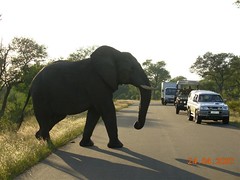
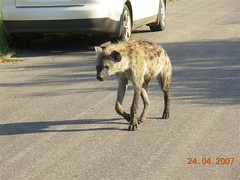
Kruger Park visit can be clubbed with a visit to diamond & gold mines on your return to Johannesburg. All purchase made in SA will be charged VAT which can be claimed back at airports of departure in the prescribed counters.

Jacob Koshi M ( Click on the photo)
|
Posted by
Susan Sharma
on
June 25, 2007

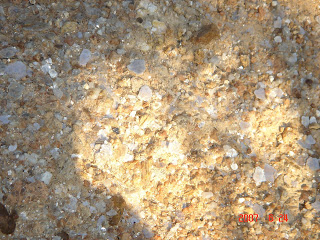
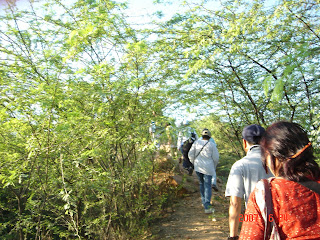
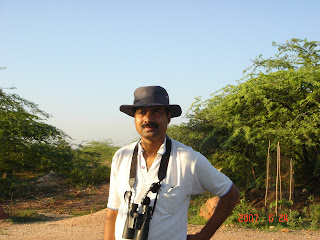
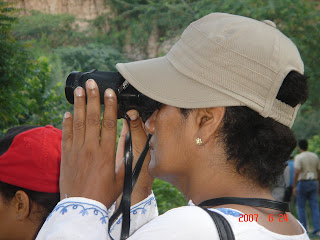
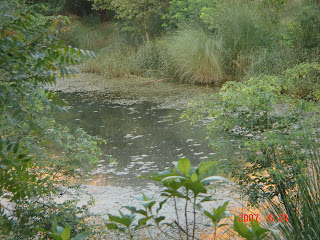
Nature does not protest, it adapts!
The Delhi bird Group organized a Sunday morning walk in the Aravali Biodiversity Park, Vasant Kunj, New Delhi. Here are some thoughts from the walk.
The Aravali Bio diversity Park is formed out of degraded land reclaimed from the business house of Scindias who had a mining lease for the 2.3 sq.km area. This means that anything that can be plundered out of the forest/earth including mica, sand and water
have all been taken out.
So instead of the sprawling forest the ridge was once, we have land pockmarked by pits and hillocks with "Vilayati Keekar" growing all over, thanks to the areal seeding done by the forest department.
2004- Enter the DDA and Delhi University. The pits are cemented (with biodegradable slurry) to encourage rainwater retention. Native trees are planted under a systematic planting program to slowly remove the "Vilayati Keekar", which being an exotic species
do not harbour native insects or birds.
June 2007 - A group of nature lovers take a walk in the Park. Dr. M.Shah Hussain along with Dr.Yasir lead the walk.
Coppersmith! little cormorant in flight! Koyal! Parakeets! The birders are excited at almost every turn.
As we walked on, Indian Robin, Red Vented Bulbul, White Eared Bulbul, Purple sunbird, common Mynas, Wren Warbler and some flying Black kites become common sightings during the trail. Plain tiger butterflies and blue pansy flitted about in the area
where native vegetation has started taking root.
At least a couple of peacocks showed up close; though the morning was pierced by their calls often.
Every now and and then a thundering sound of planes taking off from the airport nearby kept reminding us we are not far from an international airport.
As we reached the periphery of the park, a bevy of peahens took off into the air. Monsoon is expected in a week, and all of them must be having eggs about to be hatched or just hatched chicks. A group of over 30 walkers would have set the alarm calls for them.
They have chosen the nursery space carefully-slightly higher ground with thick bushes so that rainwater will not harm them.
Do peahens also tend to remain close to each other while raising the young? So that they can forage by turn may be? Do peahen mothers care for peachicks not their own?
At the end of the walk, one was amazed at the manner in which nature adapted. The mining pits are now small water holes attracting water cocks and cormorants-Cementing the areas with bio degradable materials -the little bit of egging on by the CEMDE, Delhi
University (Center for Environment Management & Degraded Ecosystem), is rejuvenating the forest.
Selective planting of native species like Berry, Jamun,Khiorni, Guava and Anar trees etc. are automatically collecting around them the natural biotic creatures-birds, butterflies, ferrals.
Nature does not protest but adapts!
Photographs in order of appearing
1.The soil is rich in Mica
2.Walkers in single file
3.Dr. Husain
4.Bird watcher
5. Natural lake
See photographs of som eof the birds and butterflies at DelhiBird
by clicking here
http://tinyurl.com/2t5mfy
[Open in new window]
|
Posted by
Susan Sharma
on
June 22, 2007
Comments, objections and suggestions on the draft Scheduled Tribes and Other Traditional Forest Dwellers (Recognition of Forest Rights) Rules, 2007, are being invited by the Ministry of Tribal Affairs, New Delhi to reach by the 6th of August 2007.
Comments can be sent by email too.
A copy of the Act as well as the draft rules can be viewed in the website
http://www.tribal.gov.in
|
Posted by
Susan Sharma
on
June 22, 2007

Delhi Cycling Club is organizing a bicycle rally India Gate-Red Fort at 7.AM 0n 24th June 2007
to create awareness about various benefits of cycling; Promote road safety amongst cyclists;and demand from the Government the much needed cycle
tracks on all main roads of Delhi.
About
DELHI CYCLING CLUB:
Formed by ITDP India in April 2007, Delhi Cycling Club is a forum of bicycle enthusiasts, health and environmental conscious citizens in
New Delhi.
The club has been engaged in carrying out the following activities:
- Creating public awareness and sensitization
about the environmental, health, economic, energy and other benefits of bicycling.
- Educating various decision makers and stakeholders about the need and advantages of promoting cycling and NMT in our cities and integrating them with
other modes of transportation.
- Demanding fast implementation of better and safe cycling infrastructure in
Delhi from the Government.
- Planning regular traffic safety programmes for bicycle users in association with other NGOs and Traffic Police especially amongst the students and
factory workers who are more vulnerable to accidents.
- Planning and organizing regular bike trips on various themes
such as Heritage Biking, Excursion trip, adventure trips, and bike rallies etc.
About ITDP
INDIA:
The Initiative for Transportation and Development Programmes (ITDP India) is a Delhi based NGO involved in the research and advocacy of Bus Rapid Transit
System (BRT) cities and non motorized transportation. The organization is the
India chapter of
New York based Institute for Transportation and Development Policy (ITDP). ITDP is dedicated to the promotion of transportation policies
and projects which are environmentally, socially and economically sustainable as well as equitable.
|
Posted by
Susan Sharma
on
June 19, 2007

Bear Conservation and Protection
Online chat on IWC.com
|
| 6/18/2007
Moderator:
Kartick Satyanarayan |
|
Excerpts:
Sloth Bear
The Sloth Bear is used by Kalandar Communities in India for bear dancing, However the Kalandar communities in Pakistan also use the
Himalayan Black Bear for Dancing as well as Bear Baiting practices
…
……………………………
Sloth Bear
Yes - it is possible that there could have been such brutal sports in Europe as well. Eastern Europe to this day has Dancing Bears. …..
………………..
Esskay
But then Europe is far more aware. The last issue of RD in fact carried an article on how a whole town got together to bid good bye when two of its last dancing bears were being released into wilderness
….
……………………
Vasudha
Esskay, releasing animals back into the wild is I think a scientific process that is to be done with careful thought and planning
………….
…………………..
Susan
The line between animal conservation and animal rights is blurred
………………
…………………………
Sloth Bear
Also we could make a copy of the Video "The Last Dance" available for your members if they would be interested. ……………
…………………………..
Read on at the link
http://www.indianwildlifeclub.com/mainsite/ChatTranscript.asp
|
|
Posted by
Susan Sharma
on
June 17, 2007

A modest increase in the number of urban parks and street trees in our major cities could offset decades of predicted temperature rise, a new study by researchers from the University of Manchester has revealed.
According to the team, a mere 10 per cent increase in the amount of green space in built-up centres would reduce urban surface temperatures by as much as four degrees Centigrade.
This 4°C drop in temperature is equivalent to the average predicted rise through global warming by the 2080s, and is caused by the cooling effect of water as it evaporates into the air from leaves and vegetation
through a process called transpiration, said Dr Roland Ennos, the lead researcher in the team.
"Green space collects and retains water much better than the built environment. As this water evaporates from the leaves of plants and trees it cools the surrounding air in a similar way to the cooling effect
of perspiration as it evaporates from our skin. Urban areas can be up to 12°C warmer than more rural surroundings due to the heat given off by buildings, roads and traffic, as well as reduced evaporative cooling, in what is commonly referred to as an ‘urban
heat island’," said Dr Ennos.
For their study, the team took Greater Manchester as their model, and used Geographic Information System (GIS) mapping to build up a picture of the conurbation’s land use.
The team then worked out the impact of an increase in the amount of green space on the urban climate as well as on water retention.
The research also examined the effect an increased green space has on the amount of rainwater urban areas capture and retain; towns and cities lose a large proportion of rainwater through what is termed ‘run-off’
where precipitation quickly leaves the surface and drains away into streams and rivers, eventually returning to the sea.
"We discovered that a modest increase of 10% green space reduced surface temperatures in the urban environment by 4°C, which would overcome temperature rises caused by global warming over the next 75 years, effectively
‘climate proofing’ our cities,” said Dr Ennos.
Source:
Dr Roland Ennos ,Prof. John Handley and Dr Susannah Gill
“Built Environment”
|
Posted by
Susan Sharma
on
June 17, 2007

Capitalism, faced by natural obstacles, sees no alternative to a new assault on nature, employing new, high-tech armaments.
The ecological irrationality of this response is evident in the tendency to
dissociate global warming from the global environmental crisis as a whole, which includes such problems as species extinction, destruction of the oceans, tropical deforestation, desertification, toxic wastes, etc.
It is then possible, from this narrow perspective, to promote biofuels as a
partial solution to global warming — without acknowledging that this will
accelerate world hunger. Or it is thought pragmatic to dump iron filings in the
ocean (the so-called Geritol solution to global warming) in order to grow
phytoplankton and increase the carbon absorbing capacity of the ocean — without connecting this at all to the current oceanic catastrophe. The fact that the biosphere is one interconnected whole is downplayed in favor of mere economic expediency.
What all of this suggests is that a real solution to the planetary
environmental crisis cannot be accomplished simply through new technologies or through turning nature into a market. It is necessary to go to the root of the problem by addressing the social relations of production.
We must recognize that today’s ecological problems are related to a system of global inequality that demands ecological destruction as a necessary condition of its existence.
New social and democratic solutions need to be developed and rooted in human community and sustainability, embodying principles of conservation that are essential to life. But this means stepping outside the capitalist box and making peace with the planet
— and with other human beings.
-John Bellamy Foster
Professor of sociology at the University of Oregon in
Eugene, and editor of Monthly Review.
|
Posted by
Susan Sharma
on
June 15, 2007
The National Board for Wildlife has been reconstituted with the following members. The members are Mahendra Vyas, Brijendra Singh, Divyabhanu Chavda, Dr. Ranjit Sinh, Biswajit Mohanty, Sekhar Dattatri, Bonani Kakkar, Dr. Bhibah Talukdar,Dilip Khatau and
Valmik Thapar. WPSI, Reef Watch, Wildlife First, WWF-Iand BNHS are the instituional members.
|